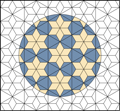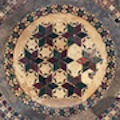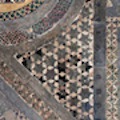Aux armes · symbolism: notes
And when Thyself with shining Foot shall pass
Among the Guests Star-scatter'd on the Grass,
And in thy joyous Errand reach the Spot
Where I made one — turn down an empty Glass!LXXV: Rubáiyát of Omar Khayyám. Translation: Edward FitzGerald (First edition, 1859).
Lo, all our pomp of yesterday
Is one with Nineveh and Tyre!Rudyard Kipling (1897). Recessional.
Notes
1. The pattern exhibited in the earlier arms (see Symbolism: Fig. b) has been in widespread use throughout the Islamic world[a] from early-medieval times and in later European Jewish documents. Notwithstanding the then ardent and vicious hostility of many Christians towards Judaism and Islam, this origin seem to have been no barrier to its adoption in thirteenth century England and Italy, most notably in ecclesiastical art and architecture. Significant early examples of the pattern in medieval Europe include:
-
The tomb of Henry III, Westminster Abbey (c.1291)
The ‘Seven Stars’ badge resembles a stellate motif to be found in several of the Cosmati roundels on the plinth of the tomb of Henry III. Although the implicit geometry of this motif is congruent with that of the badge, its elemental composition is not identical: the roundel (Fig. 1) shows a circumscribed portion of an extended plane of abutted hexagrams, instead of an aliquot part as in the badge (Fig. 2).
The pattern of the tesserae is shown in Fig. 1 in grey, with the motif coloured: the stars are set in rhombille tiles3 on a contrasting ground composed of equilateral and isosceles triangular elements. This illustration somewhat amends the irregular geometry of the actual work — although as the plinth was readily accessible to generations of relic-seeking pilgrims, who have stripped it of much of the accessible decoration, these flaws may be the result of inept restoration rather than the original work.
-
The Cosmati pavement before the High Altar in Westminster Abbey is the apotheosis of medieval opus sectile work north of the Alps. A Latin inscription added after the death of Henry III in 1272 records that:
XPI: MILLENO: BIS: CENTENO: DUODENO: CUM: SEXAGENO: SUBDUCTIS: QUATUOR: ANNO: TERTIUS: HENRICUS: REX: URBS: ODORICUS: ET: ABBAS: HOS: COMPEGERE: PORPHYREOS: LAPIDES
In 1268 the third King Henry, the city, Odoricus and the Abbot [Richard de Ware] put these porphyry stones together.
After nearly six hundred years of constant use it was hidden in obscurity for almost a hundred and fifty years, until it was revealed in 2008: thus showing the precursor of the plinth motif (Fig. 3b).
There is a similar and contemporaneous pavement in the adjoining Chapel of Edward the Confessor (which was built above the Saint's original crypt and tomb to contain his new monument in 1269). Both the pavement and monument are recorded as being the work of Peter the Roman. The consistent workmanship and artistry in all these works support the compelling presumption that Odoricus, Peter the Roman and Pietro di Oderisio were one and the same person.
A pattern in an alternative rendering of the arms (see Symbolism: Fig. d) is evident in both the Westminster pavement (Fig. 3c) and in the Mausoleo del cardinale De Braye, Orvieto.
Notwithstanding these influences, the Trinity Chapel of Canterbury Cathedral contains an opus sectile pavement which may have been a model for the Westminster pavement: a design striking enough to be recorded by an historian of the period, William of Malmsbury:
While at Canterbury, Ernulph, having taken down the eastern part of the church [the Cathedral] that Lanfranc built, erected it so much more magnificently that nothing like it could be seen in England, either for the brilliancy of its windows, the beauty of its marble pavement, or the many coloured pictures that led the wondering eye to the very summit of the ceiling.
William of Malmsbury (c.1090–c.1142). De Gestis Pontificum Anglorum (c.1125).
There is presently no certainty that the extant pavement is that referred to in the chronicle: the scholarly consensus being that it is from the mid-thirteenth century. Even so, its influence on the Westminster pavement is slight: despite invasive restoration in the nineteenth century, the intact original elements exhibit distinct differences from the Westminster works, in geometrical morphology, materials and construction.
On hexagrams
The abundant use of hexagrams in the pavements and monuments of Westminster Abbey now seems incongruous to a Christian setting, particularly as both Henry III and Edward I were zealously anti-semitic — amongst his numerous oppressions, Henry extorted exclusive and onerous taxes from the Jewish community and later, with the Edict of Expulsion of 1290, his son expelled all Jews from the kingdom and expropriated their property. Nor are the emblems unique as Christian hexagrams, six-pointed stars were common motifs in medieval cathedrals and churches throughout western Europe and the Megan David (מגן דוד, properly the ‘Shield of David’ but more commonly known as the ‘Star of David’) was not seen as a specifically Jewish symbol by Christians throughout the twelfth and thirteenth centuries. Hence when Henry III decreed that all Jews within his realm wore a “badge of shame” this was cruelly and sardonically prescribed as the profile of the Mosaic Tablets of the Law and not the then unrecognised Megan David. Thus it is implausible that the presence of hexagrams in the pavements then evoked Judaic antecedents. Although lacking the geometric subtlety of their immediate precursors the redolent Islamic inspiration for the pattern is now plain (itself derived from earlier Jewish sources), yet during that time this too was obscure and esoteric. Not that the hatred and bigotry these medieval rulers felt towards Islam was any less implacable than theirs for Judaism: rather, they were probably ignorant of and utterly indifferent to the provenance of such esoteric decorations.
The earliest evidence of the symbol in a Jewish context, or indeed a Middle-Eastern one, is in the architectural ornamentation of a fourth or fifth century synagogue in Capernaum, Galilee — which was evidently built over an earlier synagogue, perhaps contemporaneous with Jesus (Luke 7:1–10). However its use there may have been merely decorative, since it is interspersed amongst other ancient geometric patterns, such as meanders and pentangles. The historical record of Judaism in the following five centuries is empty of references to the symbol: it is next recorded in rabbinical manuscripts and in codices from the early-eleventh century, ostensibly as a Kabbalistic symbol — firstly in a carpet page of the Leningrad Codex of 1008, the oldest extent manuscript of the Hebrew Bible. By then it is usually seen in the form of the Megan David, but its first recorded use as an explicit emblem of Jewish identity followed much later, in 1354, when the Holy Roman Emperor Charles IV granted the Jewish community of Prague the right to display a flag bearing a single six-pointed star. However it was not until the seventeenth century, again in central and eastern Europe, that the widespread use of the Megan David as a distinctly Judaic symbol emerged. This latter tradition was probably the inspiration for its adoption by the Zionist movement, following the advocacy of a flag with seven hexagrams by the preeminent early Zionist Theodore Herzl (1860–1904), although his design was not used.
Whether or not Islam took the pattern from a Judaic emblem is unknown. It could have been an independent invention of Persian artists, as one of the prolific range of advanced geometric patterns derived from the sophisticated mathematics of the medieval Persian Schools.[d] Earlier still, the Shatkona (a hexagram) was common in the cosmological iconography of Hinduism and Buddhism, but its origins are lost in Indic antiquity. An identical Japanese figure is found on many of the late seventh century stone lanterns (dai-dōrō) on the approach path (sandō) in the Shinto shrine of Jingū.
Despite this widespead usage, the display of multiple hexagrams in extended patterns remained peculiar to early-medieval Islam and only later became common in Christian Europe.
As part of a pervasive revolt against reason, the late-twentieth century saw a proliferation of delusional conspiracy theories.§1 In some, the hexagram is ascribed to purported secret societies such as the successors to the Illuminati and a mishmash of crypto-satanic cults. This appears to be founded on a combination of specious numerology — 666 is the “Number of the Beast” in Revelation 13:18 — an ill-informed obsession with the iconography of Freemasonry§2 and blatant anti-Semitism.
See:
- Cosmatesque Hexagrams: a photographic collection of magnificent architectural art.
- Dr. Ze'ev Goldman (2010). Magen David Symbol Research from the 1st to the 11th century C.E.
- Gershom Scholem (1949). The curious history of the six-pointed star: how the ‘Magen David’ became the Jewish symbol.
- Star of David blog: the Star of David, its history, meanings and usage in various cultures.
-
The tomb of Henry III was commissioned by his son and successor, Edward I, who would have been familiar with the novelty and slendour of the works of the Cosmati school,* both from the Westminster pavements and, perhaps, in a notable Italian examples: namely, the funeral monument to Pope Clement IV in San Francesco alla Rocca (q.v.) in Viterbo, which was completed in 1270 and exhibits Pietro di Oderisio's characteristic Cosmati decoration. Edward passed through Italy on his return from the Ninth Crusade in 1273. His itinerary[e] is known to have included a brief stay in Rome followed by a prolonged stay at the Papal Court in Orvieto. Although unrecorded, it is likely that — a least for short periods — he was also in Sutri and Viterbo, then the only substantial towns between them on the Via Cassia. Rome and Orvieto are some seventy-five miles apart and a winter journey to Orvieto must then have taken at least three days. As a devout Christian, his stay in Viterbo would plausibly have entailed a pilgrimage to the recent papal monument. It seems improbable that he would not have visited the site of the death of Henry of Almain, his cousin and close friend from childhood, who had been murdered there during Mass in the Chiesa di San Silvestro less than two years before.[f]
* The Italian school were in turn inspired by the numerous Islamic pavements in the former Emirate of Sicily (831–1072), then a re-conquered Christian Kingdom — Edward was there throughout the winter of 1272 – 73.
2. The significance of all symbolism is mutable. An astronomical interpretation may seem obvious to us, but in other times and other places other connotations were evoked: apart from those few scholars familiar with the works of Ptolemy and Aristotle, the science of astronomy was unknown in medieval England and although such emblems denoted the starry heavens, they would then have been endowed with a predominantly religious significance. Now an array of stars with an inverse pattern recalling the molecular bonding pattern of carbon rings may seem a doubly-apt emblem for a member of a carbon-based life form assembled from the ‘stardust’ or debris of successive supernovæ.[g]
Les gens ont des étoiles qui ne sont pas les mêmes. Pour les uns, qui voyagent, les étoiles sont des guides. Pour d'autres elles ne sont rien que de petites lumières. Pour d'autres qui sont savants elles sont des problèmes.
People have stars that are not the same. For some, who are travellers, the stars are guides. For others they are no more than little lights. For others, who are scholars, they are problems.
Antoine de Saint-Exupéry (1943). Le Petit Prince.
3. The intrinsic geometry in the arms as shown in Figures b & d and the ‘Seven Stars’ badge is a rhombille tessellation, as it is reducible to an isohedral periodic tiling of identical 60° rhombi in a Euclidean plane (Fig. 2). The patterns in Figures b and d are also more generally tilings by regular polygons.
4. The term ‘Flower of Life’ is a twentieth century neologism of unknown origin. While the pattern itself is ancient, it has been the subject of a recent plethora of esoteric speculation about its supposed primeval ubiquity, remote antiquity and symbolic significance[h] and some rational scrutiny.[i] In reality, early examples are scarce and confined to the eastern Mediterranean and Mesopotamia, where the earliest datable specimen is from Nineveh c. 645 BC, as the extended pattern in an alabaster threshold from the palace of Ashurbanipal (King of Assyria, 668–627 BC). This bears a strong resemblance to a representation of a carpet, perhaps aptly given its original purpose (now in the Near Eastern Antiquities Collection of the Louvre, Paris). The earlier Osireion[j] in the temple of Seti I (1290–1279 BC) in Abydos exhibits several of the figures in its now customary form (Fig. 4): but the origin of these is uncertain. Purely geometric ornamentation is uncharacteristic of pharaonic temple architecture and the pattern is otherwise absent from Ancient Egypt. Adjacent to the largest of the figures are comparably incised glyphs in Ancient Greek, which may suggest that the entire group is merely sophisticated griffiti.§3 The apparently random and non-canonical arrangement of the inscriptions on the facing stiles of a single portal in a lateral megalithic ‘arcade’, together with their height over 3 metres above the pavement level and the anomalous lightness of incision may be further evidence of their origin as griffiti — the subterranean Osireion was abandoned and silt-filled to a substantial depth throughout the Classical period, during which time the upper levels of the structure may have been readily accessible.
As for their symbolic significance, these, and the other extant early examples, display no known contemporaneous religious or sacred attributes. In Nineveh, and elsewhere, the pattern is clearly used as domestic decoration and while the Osireion figures are set in a religious structure, they are not integral to it: on the contrary, they are strikingly suggestive of the demonstrative or pedagogic diagrams of Ancient Greek mathematicians — here carved in stone rather than traced in sand — and are alien to their sacred setting. It seems the mystical and occult properties of the ‘Flower of Life’ are, like the name itself, figments of modern imaginations. Even so, bearing in mind the figure's simple but intricate beauty, perhaps such projections are understandable and innocent foibles.
§1 The present manifestation may be a reprise of an earlier benighted Europe:
A boundless, millennial promise made with boundless, prophet-like conviction to a number of rootless and desperate men in the midst of a society where traditional norms and relationships are disintegrating — here, it would seem, lay the source of that subterranean medieval fanaticism which has been studied in this book. It may be suggested here, too, lies the source of the giant fanaticisms which in our day have convulsed the world.
Norman Cohn (1970), The Pursuit of the Millennium: Revolutionary Millenarians and Mystical Anarchists of the Middle Ages. Paladin. p. 288.
See also:
Norman Cohn (1967), Warrant for Genocide: the Myth of the Jewish world-conspiracy and the Protocols of the Elders of Zion. Eyre & Spottiswoode.Anthony Julius (2010), Trials of the Diaspora: a history of anti-semitism in England. Oxford.
This is not to say that conspiracies have not and do not exist: nation states and corporations (and other sectional interests) have an manifest mutual predilection for cooperation in the pursuit of their several aims. This ubiquitous rent seeking is at least as old as the medieval Guilds; burgeoned with the growth of mercantilism in the sixteenth to late eighteenth centuries and dirigisme in the twentieth; and is now revenant and pestilential to freedom as ‘crony capitalism’. Rather, the notion that pervasive clandestine networks are covertly working towards nefarious global ends is plainly contrary to the evidence. Our shared propensity for error, which outweighs even our greed and capacity for iniquity, and a common limited understanding of the complexity of the world must constrain such endeavours. But their greatest flaw is that not all men and women are credulous and pliant, some act in an ethical and courageous manner: thus these hermetic realms are always insecure. Even so, the incoherent fears of some conspiracists are well-founded in several respects: the ambitions of aspiring oligarchies — but real rather than chimerical — with the complicity of political power may be enduring threats to freedom and property; and it is in the nature of political power that it is inimical to truth and resistant to its discovery and disclosure. Against such collusions, an Open Society under the Rule of Law is a better defence than fatuous speculation. Rigorous public scepticism and a close shave with Occam's Razor should suffice to frustrate these aims, whereas irrational concoctions and hydra-headed conspiracy theories serve to distract from genuine dangers.
§2 For instance, a widely held belief is that the emblems of the early United States incorporated esoteric Masonic symbols — in particular, the so-called ‘Eye of Providence’ on the Great Seal. This is demonstrably false: Freemasons arrogated the emblem from the young Republic in the late-eighteenth century, its prior masonic use is unrecorded. In late-medieval and renaissance Christian iconography, the ‘Eye’ inscribed within a triangle — as in the reverse of the Great Seal — was an explicit symbol of the Holy Trinity. It is from its later widespread appropriation as a quasi-religious symbol during the Enlightenment that the Great Seal derives.
Likewise, the emblems in these arms could be seen as nefarious by many adherents of conspiracy theories. It seems to them that eagles and stars are clandestine symbols of the ‘Illuminati’. Their spurious arguments, such as they are, rest on delusional fabrications erected on a slender base of apocryphal authorities and abstruse citations, such as:
Though thou exalt thyself as the eagle, and though thou set thy nest among the stars, thence will I bring thee down, saith the LORD. Obadiah 1:4.
Since the brazenly unrepentant bearer of these arms neither holds nor aspires to lofty rank and has no interstellar abode — other than on this beautiful wandering orb — he's content to trust in the beneficence of a just deity (having never “stoodest on the other side” against his brothers) and to withstand the rest.
§3 The letter forms in the inscriptions are Classical period Attic, except for the presence of a single digamma (Ϝ). The presence of this archaic Greek letter does not imply that the inscriptions date from pre-Classical times. Although the use of the literal digamma declined from the beginning of the Classical period, the glyph continued to signify the numeral 6 in the prevailing Milesian number system during the Hellenistic period and late antiquity.† The use of digamma as a specific signifier in Greek geometric delination and in musical notation persisted, even into the early Christian period. Given the evidence, the supposition that the glyphs are coeval and associated with the figures can only be tentative: however they do not form any recognizable word and together with the inclusion of digamma and their distinctive segmental paragraphical layout alongside the figures this suggests they may be an explicans in geometric notation. If so, this is a unique survivor. Thus there is no inconsistency in attributing the inscriptions to a later period. Obviously the inscriptions might be of an early date, since Greek mercenaries and travellers had access to Upper Egypt from about 664 BC,‡ but Greek contact with Egypt was only extensive following the conquests of Alexander in 332 BC. A precise date would be unsupported by the evidence.
† Uncial digamma, which closely resembled the ligature for sigma-tau — stigma (ϛ) — was a post-Classical introduction. Later, its origin as an independent glyph then long forgotten, digamma was conflated with the ligature, which thus came to represent the numeral.
‡ The sixth century BC Greek mathematican Pythagoras is recorded has having travelled widely throughout Egypt, particularly to many of its temples and religious foundations. Nonetheless the paucity of authenticated biographical detail and our total reliance on the accounts of later writers render any account that he visited the Osireion purely conjectural: as, thus, is any that considers these figures to be Pythagorean in origin.[k]
- The Metropolitan Museum of Art. Geometric Patterns in Islamic Art. New York.
- Keith Critchlow. Islamic Patterns: an analytic and cosmological approach. Thames and Hudson, 1976.
- Paul Binski. The Cosmati at Westminster and the English Court Style. The Art Bulletin. Vol.72, No.1, March 1990.
- Grant, Lindy & Richard Mortimer, eds. Westminster Abbey: The Cosmati Pavements. Courtauld Research Papers. No.3, 2002.
- Peter J. Lu & Paul J. Steinhardt. Decagonal and Quasi-Crystalline Tilings in Medieval Islamic Architecture. Science 315, 1106 (2007). Abstract.
- Henry Gough (1900). Itinerary of King Edward the First throughout his reign, A.D. 1272–1307. pp. 20–24.
- Sir Maurice Powicke. The Thirteenth Century 1216–1307. Second edition pp. 225, 226. Oxford, 1962.
- Qingzhu Yin, Stein B. Jacobsen & Katsuyuki Yamashita. Diverse supernova sources of pre-solar material inferred from molybdenum isotopes in meteorites. Nature 415, 881–883 (2002). Abstact | Full letter (131KB, PDF).
See also: Supernova: interstellar impact. Wikipedia. - Unknown author (2011). Flower of Life. Wikipedia.
- Weisstein, Eric W. (2011). Flower of Life. Wolfram MathWorld.
See also: Stephen Wolfram (2002). A New Kind of Science. Wolfram Media. pp. 44 and 872. - Murray, Margaret Alice (1904). The Osireion at Abydos. Egyptian Research Account, ninth year, 1903. ETANA.
See also: Osireion. Wikipedia. - William Smith, ed. (1873). A Dictionary of Greek and Roman biography and mythology: Pythagoras. Perseus Digital Library.
- Diogenes Laërtius. Lives of the Eminent Philosophers: Book VIII: Pythagoras. Perseus Digital Library.
- Ibid., (Trans. Robert Drew Hicks, 1925) and Vol.II. Loeb Classical Library. Harvard, 1925.
Figure 1: tiling pattern in a motif on the tomb of Henry III
Figure 2: implicit rhombille tiling in the second badge
See: rhombille tessellation and rhombille floor tiling: Piccolomini Library (1507), Siena Duomo.
Figures 3a–c: details from the Cosmati pavement, Westminster Abbey.
Figure 4: the ‘Flower of Life’ superimposed on the badge





